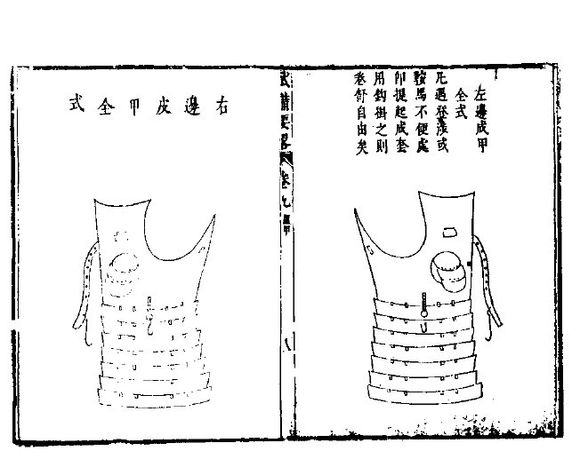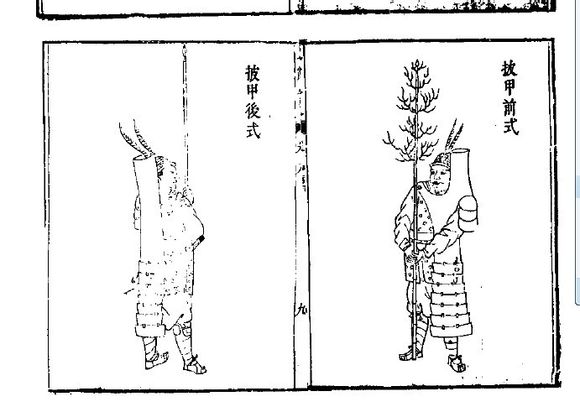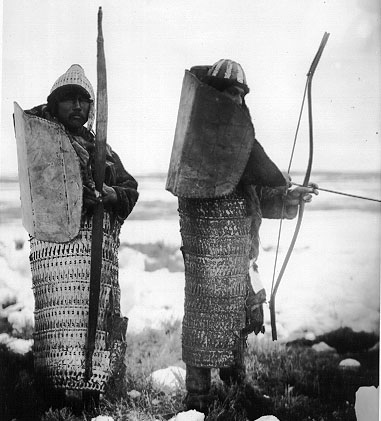Posts: 40
Thu 22 Aug, 2013 8:09 am
Chinese Ming Dynasty Extra Armour....


from now on i will never say the Chinese Ming dynasty armour is frumpy。。。。XD
it's so funy! ....and...a little cool
There are Chinese armed police mobile troop soldiers with brigandine and extra armour on southeast coast in middle of 16th century..
Posts: 63 Location: St. Louis
Thu 22 Aug, 2013 2:00 pm
Well, you don't see that every day. It looks awfully imbalanced with all the armor on the left side, and I cannot see the wisdom in leaving the defense of the empire in the hands of men armed with small trees. :p
Posts: 3,642 Location: Maitland, NSW, Australia
Thu 22 Aug, 2013 2:18 pm
What is the context for those illustrations? Could someone translate the text?
Posts: 1,504 Location: Brisbane, Australia
Thu 22 Aug, 2013 4:37 pm
Is it bulletproof?
If it's meant to stop musket shots, it would be thick, and that might make it worthwhile only covering the side facing the enemy.
Posts: 1,504 Location: Brisbane, Australia
Thu 22 Aug, 2013 4:41 pm
| Michael Wiethop wrote: |
| [...] and I cannot see the wisdom in leaving the defense of the empire in the hands of men armed with small trees. :p |
It's part of a combined-arms unit. The main offensive element in the unit is spearmen, with long spears. The multiple tip bamboo spears are to stop the enemy from closing with the spearmen. There are sword and shield men in case the enemy gets past the multiple tip bamboo spears.
Sometimes, they just used a bamboo with the branches left on, and sometimes they used a bamboo pole with iron "bamboo branches" attached.
See http://en.wikipedia.org/wiki/Ji_Xiao_Xin_Shu for some more info on the Mandarin Duck Formation.
Posts: 63 Location: St. Louis
Thu 22 Aug, 2013 8:05 pm
| Timo Nieminen wrote: |
| Michael Wiethop wrote: | | [...] and I cannot see the wisdom in leaving the defense of the empire in the hands of men armed with small trees. :p |
It's part of a combined-arms unit. The main offensive element in the unit is spearmen, with long spears. The multiple tip bamboo spears are to stop the enemy from closing with the spearmen. There are sword and shield men in case the enemy gets past the multiple tip bamboo spears.
Sometimes, they just used a bamboo with the branches left on, and sometimes they used a bamboo pole with iron "bamboo branches" attached.
See http://en.wikipedia.org/wiki/Ji_Xiao_Xin_Shu for some more info on the Mandarin Duck Formation. |
I recall reading something about this once. I never saw such strange spears, though! And the armor is even more puzzling. I can't tell if he's wearing brigandine under it or if it's the pattern of his clothing, but in any case so much armor on just one side of the body seems poorly distributed and tiring to wear. But come to think of it, it reminds me vaguely of the Brewster Body-Shield and Infanterie-Panzer from WWI. Maybe it was meant to be musketproof
Posts: 40
Thu 22 Aug, 2013 10:56 pm
| Michael Wiethop wrote: |
| Timo Nieminen wrote: | | Michael Wiethop wrote: | | [...] and I cannot see the wisdom in leaving the defense of the empire in the hands of men armed with small trees. :p |
It's part of a combined-arms unit. The main offensive element in the unit is spearmen, with long spears. The multiple tip bamboo spears are to stop the enemy from closing with the spearmen. There are sword and shield men in case the enemy gets past the multiple tip bamboo spears.
Sometimes, they just used a bamboo with the branches left on, and sometimes they used a bamboo pole with iron "bamboo branches" attached.
See http://en.wikipedia.org/wiki/Ji_Xiao_Xin_Shu for some more info on the Mandarin Duck Formation. |
I recall reading something about this once. I never saw such strange spears, though! And the armor is even more puzzling. I can't tell if he's wearing brigandine under it or if it's the pattern of his clothing, but in any case so much armor on just one side of the body seems poorly distributed and tiring to wear. But come to think of it, it reminds me vaguely of the Brewster Body-Shield and Infanterie-Panzer from WWI. Maybe it was meant to be musketproof |
[ Linked Image ]
you r right~~really looks like
This is leather armour……however,on Japanese experience,1cm+ thick Laminated leather with resins can stop medium caliber firelock bullets. Besides, in that time, southern Chinese leather armour was often coated with a thick layer of ceramic particles on the surface .
And the “LangXian”bamboo pike is a pure defensive weapon. It was used for the battle between Ming Empire armed policeman and the pirate which the Japanese wandering samurai head. AND, the Ming’s troop has made a loss exchange ratio:10:1000........with this funny weapon..
it is so easy to use: put a large clump of bamboo with steel pike head on your face and body……you will can not raise your arms and use any weapon(like katana,wakizashi... )......then, you will be poked to death by other pikeman.......
yep~The pirate had insufficient pole-arms with. It's an extreme disadvantage when facing to this bamboo pike
Posts: 3,642 Location: Maitland, NSW, Australia
Fri 23 Aug, 2013 1:44 am
| X Zhang wrote: |
| This is leather armour……however,on Japanese experience,1cm+ thick Laminated leather with resins can stop medium caliber firelock bullets. Besides, in that time, southern Chinese leather armour was often coated with a thick layer of ceramic particles on the surface . |
What is the source for this? Are there any surviving examples? Have reconstructions actually been tested against firearms?
Posts: 3,642 Location: Maitland, NSW, Australia
Fri 23 Aug, 2013 2:56 pm
But what is the context? Does this image come from a contemporary writer or is it a guess by someone from a later period? If it was European I might ask whether it was a primary source or a Victorian source.
Posts: 2,167
Fri 23 Aug, 2013 8:19 pm
I'm not certain what the exact context is. However, every Chinese person I have shown it to says that the writing is very old, (one person compared it to Shakespearian English), which suggests that the original may well have been written in the Ming Dynasty. But whether it is originally from there, or a later copy of an earlier text, I cannot say. Similarly, what the text's purpose was, and why it was written, is unknown to me.
Posts: 8 Location: Uk
Sat 24 Aug, 2013 12:20 pm
Taking a risk here with Wikipedia but they have this picture
http://en.wikipedia.org/wiki/Eskimo
About half way down
Which looks a lot like the armour in question
Cheers mat.
 Attachment: 58.01 KB
Attachment: 58.01 KB

Posts: 3,642 Location: Maitland, NSW, Australia
Mon 26 Aug, 2013 1:50 am
Also, where is the evidence for Chinese leather armour that was covered with ceramic particles? How is this coating supposed to have any effect on its protective capacity?
Posts: 3,642 Location: Maitland, NSW, Australia
Mon 26 Aug, 2013 8:09 am
| Philip Dyer wrote: |
| Dan Howard wrote: | | Also, where is the evidence for Chinese leather armour that was covered with ceramic particles? How is this coating supposed to have any effect on its protective capacity? |
Dan, bullet proof trauma plates that soldiers insert into their kevlar vests are basically ceramic plates |
Do you really think that the Chinese had access to boron carbide or silicon carbide ceramics? As far as I know they weren't developed until the 20th century. Even if they did, how does a coating of these particles stop a bullet? Ballistic ceramic is 3/4" solid plate, not fine particles.
| X Zhang wrote: |
| This is leather armour……however,on Japanese experience,1cm+ thick Laminated leather with resins can stop medium caliber firelock bullets. Besides, in that time, southern Chinese leather armour was often coated with a thick layer of ceramic particles on the surface . |
One centimeter of leather can't stop a bullet no matter what you coat it with. It would need to be that thick just to stop a heavy bow. Some boofhead probably discovered that they used a ceramic powder mixed with the lacquer on leather armour and wrongly assumed that it had some protective capacity. More likely it was just a colouring agent.
Posts: 2,167
Mon 26 Aug, 2013 7:29 pm
By the way, I have a translation for the top right image that comes from someone who teaches Chinese literature:
"A set of armor is equipped at the left side. In case of inconvenient situations such as climbing mountains, crossing water or riding horses, the part of armor below the belt can be lifted and hitched with a hook; in this way, one can move freely and easily."
Posts: 1,303 Location: Jackson, MS, USA
Mon 26 Aug, 2013 9:16 pm
The addition powdered glass and other hard materials to leather armor was known in Europe and the Middle East as well. See the following thread on Armour Archive, relevant excerpts given below.
http://forums.armourarchive.org/phpBB3/viewto...p;t=131492
Ashmole 1389, p.36
| Quote: |
For to make a doblet of fensce:
Take lether that ys half tannyd and drye hym, and schave the flesshe syd; and take glwe wt water, and set yt over the fyere, and melte yt wt water, and then al hote ly yt a pone the leder on the flesshe syde, and strawe ther on the powder of glasce bete yn a brasene morter wt fylyne of yrene y mellyd to geder; and then laye a nother pece of the same lether flesshe seyde to flesshe, and nayle hym to the scylde and lete hyme drye, and ther nother sper nother ege tole enter ther ynne. |
That is,
How to make a doublet of defense
Take leather that is half-tanned and dry it, and shave the flesh side; and take glue with water, and set it over the
fire, and melt it with water, and then when hot lay it upon the leather on the flesh side, and strew thereon the powder of
glass beaten in a brass mortar with filings of iron mixed together; and then lay another piece of the same leather
flesh side to flesh, and nail it to the form and let them dry, and then neither spear nor edged tool will enter therein.
| Russ Mitchell wrote: |
From Nicolle, David. Jawshan, Cuirie, Coats-of-Plates: An Alternative Line of Development for Hardened Leather Armor, in Compantion to Medieval Arms and Armour, ed. David Nicolle, Boydell Press 2002.
There are several recipes, much too long to transcribe here, but I'll transcribe one sample for y'all:
[p204]
| David Nicolle wrote: | Al-Tarsusi's instructions for the making of leather shields similarly reflects the high level of leather technology in Egypt at the time, and they also have similarities with the making of the cuirass:
| Al Tarsusi wrote: | | Take a clay mould with the dimensions you require for the turs [round shield] or other form [of shield], or better still go to the potter and ask him to make a mould of the sort you require. Cover it with teh skin which you have chosen, lay it long-ways with the 'bowels' and the 'glue' to soak into it, and leave to dry. Do the same sideways with the ground up spleen or with blood. Scatter over it crushed marble through a sieve, leave to dry, and attach it also lengthways and breadth-ways in the same manner as you did the first time. Smear it with the fish glue and the spleen; sieve over it the scrapings of shaburqan ['hard iron' or 'natural steel']; that is to say the iron filings abundantly, leave to dry. Smear with spleen and fish glue, sieve over it pulverized glass and marble abundantly, leave to dry. Replace the fish glue, with plenty of iron filing, as much as will be soaked up, and leave to dry. Again attach lengthways and breadthways, then 'powder' it with wood-dust which you have reduced to ash, and again leave to dry. If you want your shield 'sculptured,' double it [meaning unclear] and do as you would for ceramics [probably indicating that the resulting shield could be shape d much as a potter shaped clay].* If you want it to have a picture, put on it whatever you want.... This shield cannot be penetrated by an arrow or any other device. Dry it well. |
|
|
Posts: 3,642 Location: Maitland, NSW, Australia
Mon 26 Aug, 2013 11:12 pm
Is it bulletproof?
Posts: 1,303 Location: Jackson, MS, USA
Tue 27 Aug, 2013 7:38 am
IIRC, Peterson gives an account of the Virginia colonists trying to impress the natives by showing them a leather
shield which resisted shot, but after it was pierced by an arrow, the colonists scrambled for a steel targe to have the native "re-do" the test.
You
cannot post new topics in this forum
You
cannot reply to topics in this forum
You
cannot edit your posts in this forum
You
cannot delete your posts in this forum
You
cannot vote in polls in this forum
You
cannot attach files in this forum
You
can download files in this forum




